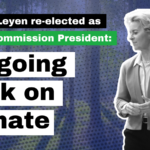MEDIA BRIEFING
The European Council, the meeting of all EU Heads of State and Government, will come together on 24-25 May, to discuss how the EU can implement its recently adopted target of cutting net emissions by at least -55% in 2030, compared to 1990 levels. The new 2030 target has recently been enshrined in the EU Climate Law and forms the overall objective of the “Fit For 55” legislative package to be published by the European Commission this 14 July.
Three topics are on the agenda of the European Council meeting: climate change, COVID-19, EU-Russia relations. The discussion on climate change is expected to focus on how the EU can implement the new EU 2030 climate target of at least -55% net emission cuts which was agreed by the European Council in December 2020. In their December conclusions, Heads of State and Government also agreed to provide “additional guidance”, in particular on the role of the Effort Sharing Regulation, a key EU climate policy file which sets national binding targets for emissions from transport, buildings and agriculture (and waste sectors). This guidance from EU leaders is also a moment for Member States to give feedback to the European Commission on its plans to revise key EU climate legislation under the so-called Fit For 55 package, scheduled to be launched on 14 July.
What is the “Fit For 55” legislative package?
The Fit For 55 package is a basket of 11 legislative pieces meant to bring the EU’s climate and energy policy framework in line with the increased overall climate target of at least -55% net emission cuts by 2030. According to the current agenda, the EU will (at least partially) launch the Fit for 55 package on 14 July 2021. Inter alia, the package includes revisions of the Emissions Trading System (ETS), the Effort Sharing Regulation (ESR) and the Land Use, Land Use Change and Forestry Regulation, the three key EU climate files that implement the EU’s climate ambition across all economic sectors.
What is the EU’s 2030 climate target, its nationally determined contribution (NDC)?
The EU’s nationally determined contribution or its 2030 climate target is the EU’s official contribution to the achievement of the global temperature goal of the Paris Agreement. In the Agreement, all countries have committed to pursue efforts to limit global temperature increase to 1.5°C by the end of this century. The European Union has recently agreed to increase its contribution for 2030 by adopting a new commitment to achieve at least -55% net emission reductions, compared to 1990 levels (up from the previous -40% emission cuts).
Is the EU’s new 2030 climate target enough to avoid dangerous climate change?
No. Despite recently enhanced commitments, notably from the US and the EU, the world is still not on track to achieve this objective. The UN’s Emissions Gap Report still predicts that current efforts equal a temperature rise of 2.5°C, well above the Paris Agreement’s objective. Europe, as a rich, industrialised economy and a major historic emitter, needs to do more than the global average. In light of its capacity to act and principles of global equity, the EU should increase climate action domestically to achieve at least -65% emission cuts by 2030 and climate neutrality by 2040.
What are the main proposals of the European Commission to achieve the new EU 2030 climate target?
The EU’s 2030 climate target is mainly implemented through three pieces of EU climate legislation:
-
the EU Emissions Trading System which covers emissions from the power, the industry and the (domestic) aviation sectors.
-
the Effort Sharing Regulation covering emissions from road transport, buildings, agriculture and waste
-
The LULUCF Regulation which deals with land based emissions and carbon removals from forests, wetlands and peatlands.
The previous EU 2030 climate target of -40% emission cuts was divided into a -43% emission reduction target for the ETS (compared to 2005 levels) and a -30% target for the ESR. The ESR target in turn is divided into 27 national binding targets.
Last year, the European Commission has published its impact assessment on how to achieve a higher level of increased overall climate ambition, the Climate Target Plan. In addition to increasing the respective targets for the ETS and ESR, the European Commission is also considering substantial changes to the existing policy architecture.
First, carbon removals which previously were not counted as a contribution to the EU’s overall climate target will now be taken into account to achieve the -55% target. This means, effective greenhouse gas reductions by the ETS and ESR combined will only achieve -52.8% emission cuts by 2030, with carbon removals bridging the gap.
Secondly, the European Commission is considering extending carbon trading to the road transport and buildings sectors and possibly taking them out of the scope of the ESR and therefore its nationally binding targets.
Third, the European Commission is also considering merging the regulation of the LULUCF sector with agricultural emissions to create a new AFOLU (agriculture, forestry and land use) pillar.
These changes combined could lead to the Effort Sharing Regulation being repealed altogether.
Member States positions and ambition gaps
EU Member States need to be held accountable for reaching the EU’s new 2030 climate target. Therefore, it is of vital importance that each country does its fair share and is accountable for agreed emission reductions to come to the goal by 2030. In order to contribute to the 1.5°C goal of the Paris Agreement, the EU should achieve at least -65% emission reductions and climate neutrality by 2040 already. The upcoming revision of key EU energy and climate legislation is an opportunity for the EU as a whole and all Member States to substantially ramp up climate action.
Currently, some Member States, especially in Central and Eastern Europe have considerable ‘ambition gaps’ between their 2030 and 2050 targets. This means that while doing very little or nothing to reduce greenhouse gas emissions until 2030, their emissions trajectory must take a drastic downturn after 2030 to reach zero emissions in the next decades. The coming decade is critical to bring the EU on a Paris Agreement consistent pathway. Delaying action will result in a much less cost-effective trajectory that will massively increase costs for later generations. This is clearly not the best approach from a socio-economic point of view.
Will the European Commission’s proposals be sufficient to achieve the new EU 2030 climate target?
This will depend on many different factors. First, the targets of the different legislative pieces need to be significantly increased. The Commission should give meaning to the “at least” prefix of the new -55% target and ensure that the proposals contain options that can increase the collective ambition of the package well beyond the net -55% which are not aligned with the 1.5°C consistent pathway for the EU. Second, the package’s environmental integrity needs to be strengthened.
The current proposal to use the enhancement of carbon removals as trade-offs for higher climate ambition undermines the fact that we need to maximise efforts in all economic sectors, net emitting and net removing sectors. At the same time, the extension of emissions trading to ESR sectors further undermines the integrity of the package as it threatens to weaken binding targets for member states. The opposite is necessary: nationally binding targets, climate governance and accountability of member states for climate action has to be strengthened. Third, the proposals, currently scheduled to be launched in mid July, will then go to the co-legislators, the European Parliament and the EU Council. These can still significantly change the ambition and integrity of the policy files, for better or for worse.
What is the EU Emissions Trading System and what is its role in achieving the new EU 2030 climate target?
The EU Emissions Trading System (ETS) is a piece of EU climate policy that covers emissions from the power, the industry and the (domestic) aviation sector, currently representing around 40% of total EU emissions. It creates a market for emission allowances (EUAs) by setting a progressively decreasing emissions cap and allowing installations to trade permits at market price. After a decade of failure to generate any meaningful carbon price levels, EUA prices have recently risen to more than 50EUR/tCO2 and achieved significant emission reductions, mainly in the power sector. In light of the increased EU overall climate ambition, the system needs a substantial reform, especially in order to eliminate the continued systemic surplus of allowances, to bring the emission cap closer to real emission levels and to start tackling industrial emissions which have stagnated for many years.
Is the extension of the EU Emissions Trading System to emissions from the transport and buildings the right way to reach the new EU 2030 climate target?
No. While carbon pricing is essential to ensure the Polluter Pays Principle, it is definitely not the right tool to address key non-market barriers (like high upfront investment needs, lack of infrastructure or alternatives, no information, etc.) to deploying clean energy solutions at scale in the transport and building sectors. Dedicated policies and measures to tackle these barriers should be a priority. Emissions trading is not a silver bullet and could shift costs to lower income households, exacerbating social divisions in the EU. Especially extending emissions trading to transport and buildings sectors and taking them out of the scope of the Effort Sharing Regulation (national responsibility) would severely undermine the environmental integrity of the EU climate policy framework. The EU ETS should therefore not be extended to ESR sectors. Carbon pricing can be applied by other means (e.g. in the form of carbon tax) as part of a balanced policy framework.
What is the Effort Sharing Regulation and what is its role in achieving the new EU 2030 climate target?
The Effort Sharing Regulation is one of the main pillars of the European climate architecture, establishing binding annual greenhouse gas emission targets for Member States for the period 2021–2030. These targets concern emissions from most sectors not included in the EU Emissions Trading System (EU ETS), such as transport, buildings, agriculture and waste. The sectors under the ESR together account for 60% of EU emissions. The overall EU ESR target is divided into 27 nationally binding targets (and the national ESR targets are translated into 10 annual targets for the period 2021-2030 for each of the 27 EU Member States). The ESR is an indispensable regulatory tool because it ensures Member State responsibility and accountability for their domestic efforts to tackle climate change. The Commission will evaluate and report annually on progress towards achieving the targets. If any Member State is not on track, they will be required to make an appropriate action plan. The EU Commission can initiate infringement proceedings in case of non-compliance.
What will be the next steps? What are the roles of the European Parliament and the EU Council?
As a next step, after the European Council debate, the European Commission will launch its Fit For 55 package, currently scheduled for the 14 July. This package, 11 policy files in total, will then initiate a wave of legislative procedures that will go to the EU co-legislators, the European Parliament and the EU Council which then need to come to a joint agreement in order to adopt new law. Since the time horizon of the revisions on the table is 2030, there is pressure on EU institutions for a swift negotiation process in order for the revised policy files to come into effect as soon as possible.


